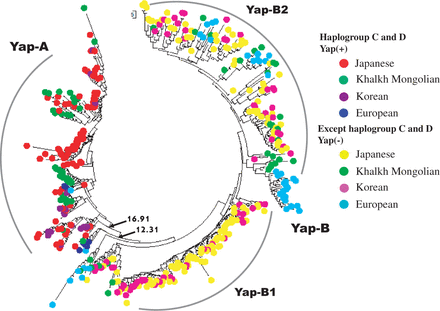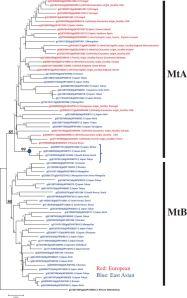Source - http://heritageofjapan.wordpress.com/
The traditional view that humans fall into three major populations, Africans, East Asians, and Europeans, with the latter two diverging from the African ancestors ∼55,000 years ago, has been re-examined by a group of researchers, who have come to a bold and different conclusion — and who have put forward a new view that East Asians diverged from Africans first, and that only later did the Europeans diverge from the East Asian grouping.
The study also proposes a new theory of origins of the Ainu. The long-debated and mystifying European appearance of the Ainu people is explained, as congruent with the idea that the Ainu people emerged at the point of time when Europeans were beginning to diverge from East Asians.
The results of the research has just been published in the Genome Biology and Evolution Journal, entitled “Divergence of East Asians and Europeans Estimated Using Male- and Female-Specific Genetic Markers” by Yoshio TATENO et al. Genome Biol Evol (2014) 6 (3): 466-473. doi: 10.1093/gbe/evu027
Excerpted from the paper:
“We sequenced Y-STR makers in Y chromosome and collected complete mtDNAs for many East Asian and European individuals to reexamine that view” … “focused on the divergence of three major populations — Africans, Europeans, and East Asians—and East Asians and Europeans in particular, because they lived together for a while after coming out of Africa and likely interbred, perhaps similar to the hybridizations reported between Neanderthals and modern humans (Noonan 2006). After the divergence between Mongoloid (East Asian) and Caucasoid (European) people ~55,000 years ago (Nei and Roychoudhury 1993), they might have still interbred while en route to settlement in their present localities…”
“For the male lineages, we used the Y-STR markers for 453 individuals covering Japanese, Korean, Mongolian (Khalkh), American, and European people. We determined the evolutionary distances (RST) among them, and constructed a phylogenetic tree using the NJ method (Saitou and Nei 1987), as shown in figure 1. The Y-STR tree revealed that the male ancestral lineage contained two clades (Yap-A and Yap-B). While Yap-A clade includes the East Asian individuals only, Yap-B clade contains the East Asian and European individuals together. Surprisingly,the European males never formed an independent clade. Instead, they formed separate clades within Yap-B.”

Fig. 1
” We then constructed a phylogenetic tree (Mt tree) for the 72 complete mtDNAs including the four ethnic groups, as shown in figure 2. We used Kimura’s two parameter method (Kimura 1980) for computing evolutionary distances among them and the NJ method for the tree construction. The Mt tree revealed two female descendant clades (Mt A and Mt B). Mt B consisted of the East Asian females only, while Mt A contained the East Asian and European females together. As in the case of males, the European females did not form an independent clade, but comprised several groups within the Mt A tree. As the Mt A cluster includes roughly as many European individuals as East Asian individuals, it is not clear which of them is ancestral to the other. Thenode marked with the blue circle in figure 2 suggests that the East Asians are ancestral to the Europeans. The bootstrap value of the node is 99%. Therefore, both male and female lineages suggest that Europeans diverged from within East Asian ancestors or that they interbred with East Asian individuals up to a certain divergence time.

Fig. 2
Our next question was thus to estimate the divergence time of the European clade within the East Asian lineage, for males and females separately. To address that question, we computed the evolutionary distance (RST) between every pair of the male individuals to construct the Y-STR tree in figure 1. The researchers’ conclusion was that “the divergence time of the European males is ∼40,100 years ago” while they “estimated the divergence time of the European females, as ∼41,500 years ago.”
“Our results suggest that the European people settled down in their territories ∼41,000 year ago, and have developed their own cultures and languages since then.
On the other hand, the East Asians were classified into two clusters; one is Type 1 East Asians denoted as Yap-A [this is the grouping that carries C,D hgs and YAP+ genes, i.e. the Jomon and Ainu ancestral line] and Mt B clusters in the male and female trees, respectively, and the other is Type 2 East Asians denoted as Yap-B and Mt A clusters in the male and female trees, respectively.
While Type 1 includes East Asian individuals only, Type 2 contains East Asians and European individuals together.
FIG. 4.— The general view of the East Asian and European divergences is summarized in figure 4.

Fig. 4 Phlyogenetic tree of the major human populations Africans, Type 1 East Asians, Europeans and Type 2 East Asians
“Both the Y-STR and mtDNA trees consistently show that Europeans diverged from East Asian ancestors ∼41,000 years ago.”
Dealing with the question of differences in facial morphology and phenotypes, the paper proposed:
“Population genetic theory indicates that 41,000 years, or about 2,000 generations, are long enough to accumulate SNPs in the same loci in each lineage (Kimura 1983; Nei 1987) to account for the present genetic and phenotypic differences between the East Asians and Europeans, but too short to acquire independent loci between them. Recently, Liu (2012) reported on five genes responsible for the facial morphology of European people. The East Asian people must have the counterparts that differ at the SNP level from those in the European people. As our phylogenetic trees demonstrate, the European alleles at the five loci have diverged from the ancestral East Asian alleles.
Our result contrasts with the traditional view that Europeans and East Asians simultaneously diverged from African ancestors 55,000 years ago. It is noteworthy, however, that Shinoda (2007) investigated into the haplogroups of mtDNA, and revealed a number of evolutionary haplotype lineages. The lineages include L3 (African), N (East Asian), W (European), and L3 to N to R (East Asian) and then HV (European) among others. Though they did not explain their results, their haplotype lineages can now be understood by our finding that the Europeans diverged from the East Asians. Therefore, the discrepancy between the traditional view and ours lies mainly in that the traditional view was based on autosomal genes that evolved much slower than Y-STR or mtDNA, and could not distinguish the evolutionary lineages at the individual level. Note that, as estimated earlier, the evolutionary rate of mtDNA is 2.4 × 10−8 per site per year, while that of nuclear neutral sequences is 2.0 × 10−9 per site per year (Fukami Kobayashi 2005). The discrepancy also is due to the fact that while we dealt with many male and female individuals in our study, the other studies did not.
Our result contrasts with the traditional view that Europeans and East Asians simultaneously diverged from African ancestors 55,000 years ago. It is noteworthy, however, that Shinoda (2007) investigated into the haplogroups of mtDNA, and revealed a number of evolutionary haplotype lineages. The lineages include L3 (African), N (East Asian), W (European), and L3 to N to R (East Asian) and then HV (European) among others. Though they did not explain their results, their haplotype lineages can now be understood by our finding that the Europeans diverged from the East Asians. Therefore, the discrepancy between the traditional view and ours lies mainly in that the traditional view was based on autosomal genes that evolved much slower than Y-STR or mtDNA, and could not distinguish the evolutionary lineages at the individual level.
… according to the classification agreed at the Y Chromosome Consortium (2002) and elsewhere (Karafet et al. 2008), we found that all individuals in the Yap-B1 in figure 1 belonged to either haplogroup C or D, while the majority in the Yap- B2 belonged to haplogroup O. Since Yap-B1 includes mainly Japanese and Korean males, in which 91% individuals share haplotype O2b, the Korean and Japanese males are definitely closest to one another within East Asian humans. We also found a high frequency of the O2b haplotype in Manchu (Northern China) and Korean-Chinese samples (Katoh et al. 2005b; Kim et al. 2011).
The origin of the Ainu people is still an unresolved issue (Tajima et al. 2004). On the basis of our results, we propose a possible scenario for the origin of the Ainu people, who now live in the north-most island of the Japanese archipelago, Hokkaido. The Ainu people have European phenotypic characters, but they are genetically closer to East Asians than to Europeans (Watanabe 1975). These contradictory features of the Ainu people are puzzling. As shown in figure 4, Europeans may have diverged from East Asians ∼41,000 years ago, it is possible that hybrid individuals were born before the divergence, and some of them looked more like the Europeans while possessing a generally East Asian genotype. We suggest that the ancestor of the Ainu people was such a group of the hybrid individuals. We note that the present Ainu people share the mtDNA haplotype not with the Japanese but with the European living in Siberia, Russia (Adachi et al. 2009). Thus, we furthermore suggest that the ancestor of the Ainu originated in northern Eurasia and took a route through Siberia and north China before settling in northern regions of Japan and nearby places. There is a report that other people than the Ainu also lived in the northern regions but disappeared (Adachi et al. 2009). As the people in Okinawa islands are closest to the Ainu people in the East Asians (Jinam et al. 2012), they might also be descendants from of mixing of East Asian and European lineages.
Conclusion:
Phylogenetic trees of Y-STR makers and Mt genes suggest that the Europeans interbred with East Asians until ∼41,000 years ago. On the other hand, East Asians diverged from their African ancestors ∼55,000 years ago. Therefore, we suggest that the European and East Asian lineages diverged ∼41,000 years ago.
Part.2